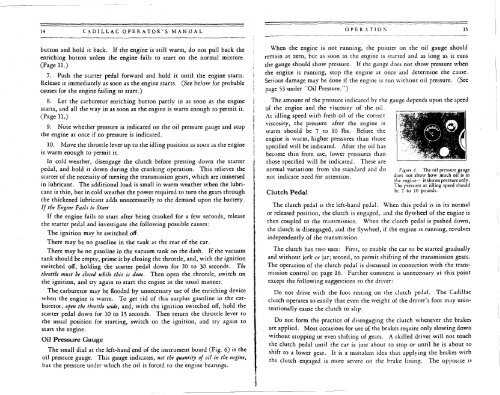1928 Cadillac - GM Heritage Center
1928 Cadillac - GM Heritage Center
1928 Cadillac - GM Heritage Center
You also want an ePaper? Increase the reach of your titles
YUMPU automatically turns print PDFs into web optimized ePapers that Google loves.
14 CADILLAC OPERATOR'S MANUAL<br />
OPERATION 15<br />
button and hold it back. If the engine is still warm, do not pull back the<br />
enriching button unless the engine fails to start on the normal mixture.<br />
(Page 11.)<br />
7. Push the starter pedal forward and hold it until the engine starts.<br />
Release it immediately as soon as the engine starts. (See below for probable<br />
causes for the engine failing to start.)<br />
8. Let the carburetor enriching button partly in as soon as the engine<br />
starts, and all the way in as soon as the engine is warm enough to permit it.<br />
(Page 11.)<br />
9. Note whether pressure is indicated on the oil pressure gauge and stop<br />
the engine at once if no pressure is indicated.<br />
10. Move the throttle lever up to the idling position as soon as the engine<br />
is warm enough to permit it.<br />
In cold weather, disengage the clutch before pressing down the starter<br />
pedal, and hold it down during the cranking operation. This relieves the<br />
starter of the necessity of turning the transmission gears, which are immersed<br />
in lubricant. The additional load is small in warm weather when the lubricant<br />
is thin, but in cold weather the power required to turn the gears through<br />
the thickened lubricant adds unnecessarily to the demand upon the battery.<br />
If the Engine Fails to Start<br />
If the engine fails to start after being cranked for a few seconds, release<br />
the starter pedal and investigate the following possible causes:<br />
The ignition may be switched off.<br />
There may be no gasoline in the tank at the rear of the car.<br />
There may be no gasoline in the vacuum tank on the dash. If the vacuum<br />
tank should be empty, prime it by closing the throttle, and, with the ignition<br />
switched off, holding the starter pedal down for 20 to 30 seconds. The<br />
throttle must be closed while this is done. Then open the throttle, switch on<br />
the ignition, and try again to start the engine in the usual manner.<br />
The carburetor may be flooded by unnecessary use of the enriching device<br />
when the engine is warm. To get rid of this surplus gasoline in the carburetor,<br />
open the throttle wide, and, with the ignition switched off, hold the<br />
starter pedal down for 10 to 15 seconds. Then return the throttle lever to<br />
the usual position for starting, switch on the ignition, and try again to<br />
start the engine.<br />
Oil Pressure Gauge<br />
The small dial at the left-hand end of the instrument board (Fig. 6) is the<br />
oil pressure gauge. This gauge indicates, not the quantity of oil in the engine,<br />
but the pressure under which the oil is forced to the engine bearings.<br />
When the engine is not running, the pointer on the oil gauge should<br />
remain at zero, but as soon as the engine is started and as long as it runs<br />
the gauge should show pressure. If the gauge does not show pressure when<br />
the engine is running, stop the engine at once and determine the cause.<br />
Serious damage may be done if the engine is run without oil pressure. (Sec<br />
page 53 under "Oil Pressure.")<br />
The amount of the pressure indicated by the gauge depends upon the speed<br />
of the engine and the viscosity of the oil.<br />
At idling speed with fresh oil of the correct<br />
viscosity, the pressure after the engine is<br />
warm should be 7 to 10 lbs. Before the<br />
engine is warm, higher pressures than those<br />
specified will be indicated. After the oil has<br />
become thin from use, lower pressures than<br />
those specified will be indicated. These are<br />
normal variations from the standard and do<br />
not indicate need for attention.<br />
Clutch Pedal<br />
Figure 6. The oil pressure gauge<br />
does not show how much oil is in<br />
the engine— it shows pressure only.<br />
The pressure at idling speed should<br />
be 7 to 10 pounds.<br />
The clutch pedal is the left-hand pedal. When this pedal is in its normal<br />
or released position, the clutch is engaged, and the flywheel of the engine is<br />
then coupled to the transmission. When the clutch pedal is pushed down,<br />
the clutch is disengaged, and the flywheel, if the engine is running, revolves<br />
independently of the transmission.<br />
The clutch has two uses: First, to enable the car to be started gradually<br />
and without jerk or jar; second, to permit shifting of the transmission gears.<br />
The operation of the clutch pedal is discussed in connection with the transmission<br />
control on page 16. Further comment is unnecessary at this point<br />
except the following suggestions to the driver:<br />
Do not drive with the foot resting on the clutch pedal. The <strong>Cadillac</strong><br />
clutch operates so easily that even the weight of the driver's foot may unintentionally<br />
cause the clutch to slip.<br />
Do not form the practice of disengaging the clutch whenever the brakes<br />
are applied. Most occasions for use of the brakes require only slowing down<br />
without stopping or even shifting of gears. A skilled driver will not touch<br />
the clutch pedal until the car is just about to stop or until he is about to<br />
shift to a lower gear. It is a mistaken idea that applying the brakes with<br />
the clutch engaged is more severe on the brake lining. The opposite is
















